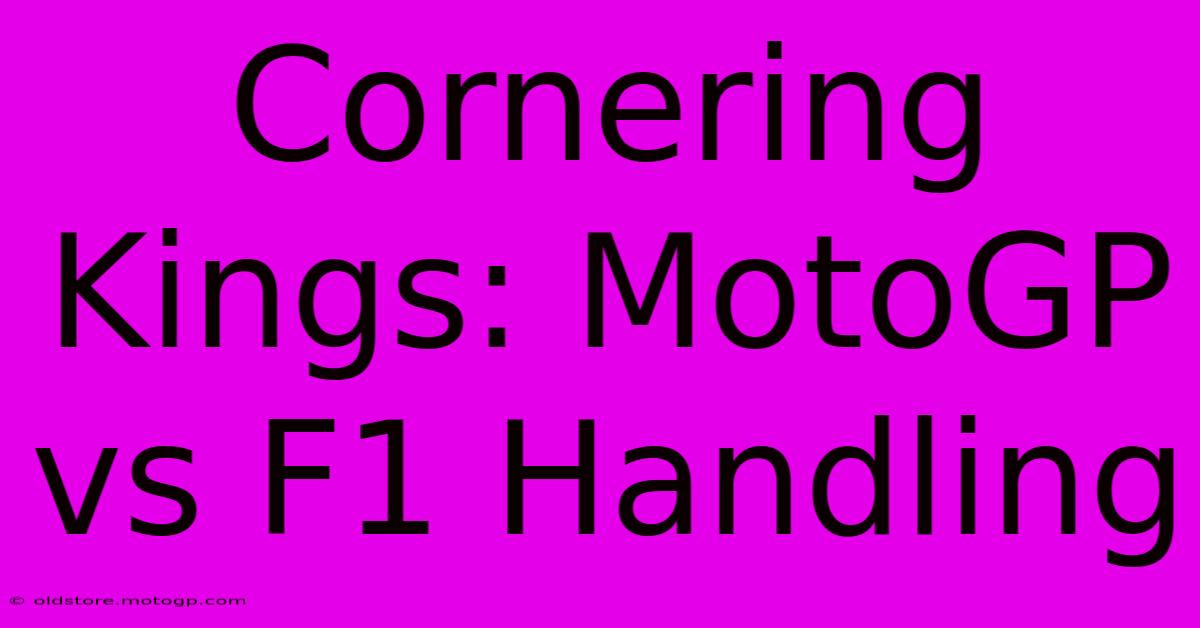Cornering Kings: MotoGP Vs F1 Handling

Table of Contents
Cornering Kings: MotoGP vs F1 Handling – A Detailed Comparison
The roar of the engine, the screech of tires, the breathtaking speed – motorsport offers a spectacle unlike any other. But when it comes to cornering, two titans reign supreme: MotoGP and Formula 1. While both feature incredible feats of engineering and piloting skill, their approaches to conquering corners differ significantly. This article delves deep into the nuances of MotoGP and F1 handling, comparing their techniques and technologies to determine which truly reigns supreme in the art of cornering.
The Physics of Lean: MotoGP's Unique Advantage
MotoGP bikes are renowned for their extreme lean angles – often exceeding 60 degrees! This is possible due to a combination of factors:
1. Lightweight and Agile Machines:
MotoGP bikes are significantly lighter than F1 cars. This reduced weight allows for quicker changes in direction and a greater ability to maneuver through tight corners. The lighter chassis means less inertia to overcome when changing direction, allowing for incredibly precise control.
2. The Art of Counter-Steering:
MotoGP riders utilize counter-steering – pushing the handlebar in the direction they want to turn away from – to initiate lean. This technique, mastered through years of practice, allows for incredibly precise and responsive cornering. It’s a fundamental skill separating MotoGP riders from other motorsports.
3. Tire Technology and Grip:
MotoGP tires are designed for maximum grip, especially at extreme lean angles. The unique construction and compounds allow for incredible traction, even when the bike is almost parallel to the ground. The grip allows riders to push harder and carry more speed through corners.
4. Aerodynamics: A Supporting Role:
While aerodynamics play a role, it's less crucial in MotoGP cornering compared to F1. The focus is primarily on the rider's skill and the bike's agility.
The Downforce Domination: F1's Cornering Mastery
Formula 1 cars, on the other hand, employ a vastly different cornering philosophy centered around downforce.
1. Aerodynamic Advantage:
F1 cars generate immense downforce through intricate aerodynamic designs. This downforce presses the car onto the track, providing exceptional grip and allowing for higher cornering speeds. The wings, diffusers, and other aerodynamic elements are meticulously designed to maximize downforce in specific cornering scenarios.
2. Powerful Engines and Traction Control:
The massive power of F1 engines demands sophisticated traction control systems. These systems precisely manage power delivery to prevent wheelspin and maintain optimal grip during corner entry and exit. The controlled power application contributes significantly to stable cornering at high speeds.
3. Tire Technology: A Balancing Act:
F1 tires are designed for a balance between grip and durability. While not achieving the extreme lean angles of MotoGP, they offer excellent grip at high speeds and under significant lateral loads.
4. Suspension Systems: Fine-Tuned for Stability:
Sophisticated suspension systems in F1 cars are crucial for maintaining stability under the high cornering forces. These systems constantly adjust to road imperfections and driver inputs, ensuring optimal tire contact and predictable handling.
The Ultimate Verdict: Who is the Cornering King?
Declaring a single "king" is impossible. MotoGP excels in low-speed, technical cornering, showcasing incredible rider skill and bike agility. F1 dominates high-speed cornering, leveraging immense downforce and advanced technology to achieve breathtaking speeds. Both disciplines demand exceptional talent and showcase the pinnacle of motorsport engineering. The "best" cornering style depends entirely on the context – the track layout, corner speed, and the desired outcome.
SEO Keywords:
- MotoGP cornering
- F1 cornering
- MotoGP vs F1 handling
- Motorcycle cornering techniques
- Formula 1 aerodynamics
- Downforce in F1
- Counter-steering MotoGP
- Lean angle MotoGP
- Tire technology MotoGP
- Tire technology F1
- High-speed cornering
- Low-speed cornering
- Motorsport technology
- MotoGP vs F1 technology
This article is structured to optimize for search engines while providing informative and engaging content for readers. Remember to promote this article through social media and other relevant channels to boost its visibility further.

Thank you for visiting our website wich cover about Cornering Kings: MotoGP Vs F1 Handling. We hope the information provided has been useful to you. Feel free to contact us if you have any questions or need further assistance. See you next time and dont miss to bookmark.
Featured Posts
-
The Psychology Of The F1 Starting Grid Pressure And Performance
Feb 23, 2025
-
Sting F1 Experience The Cutting Edge Of Racing
Feb 23, 2025
-
F1 Tomorrows Starting Grid Promises Intense Racing
Feb 23, 2025
-
Lot F Cota Enhance Your Specific Attribute
Feb 23, 2025
-
Moto Gp Accident A Look At The Rules And Regulations
Feb 23, 2025
